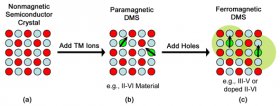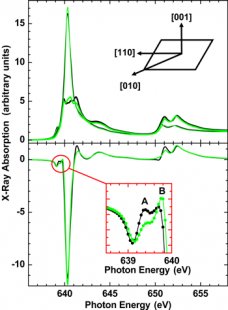 The possibility of using electrons' spins in addition to their charge in information technology has created much enthusiasm for a new field of electronics popularly known as "spintronics." An intensely studied approach to obtaining spin-polarized carriers for data-storage devices is the use of diluted magnetic semiconductors created by doping ions like Mn, Fe, or Co having a net spin into a semiconducting host such as GaAs, ZnO, or GaN. The interaction among these spins leads to ferromagnetic order at low temperatures, which is necessary to create spin-polarized carriers. A research team working at ALS Beamline 4.0.2 and European Synchrotron Radiation Facility Beamline ID8 made a big leap forward in clarifying the microscopic picture of magnetism and anisotropy in Mn-doped GaAs by resolving localized and hybridized d states using angle-dependent x-ray magnetic circular dichroism (XMCD) measurements.
The possibility of using electrons' spins in addition to their charge in information technology has created much enthusiasm for a new field of electronics popularly known as "spintronics." An intensely studied approach to obtaining spin-polarized carriers for data-storage devices is the use of diluted magnetic semiconductors created by doping ions like Mn, Fe, or Co having a net spin into a semiconducting host such as GaAs, ZnO, or GaN. The interaction among these spins leads to ferromagnetic order at low temperatures, which is necessary to create spin-polarized carriers. A research team working at ALS Beamline 4.0.2 and European Synchrotron Radiation Facility Beamline ID8 made a big leap forward in clarifying the microscopic picture of magnetism and anisotropy in Mn-doped GaAs by resolving localized and hybridized d states using angle-dependent x-ray magnetic circular dichroism (XMCD) measurements.
Three types of semiconductors: (a) nonmagnetic semiconductor, which contains no magnetic ions; (b) diluted magnetic semiconductor (DMS), i.e., a cross between a nonmagnetic semiconductor and a magnetic transition-metal (TM) element, in a paramagnetic state; (c) DMS with ferromagnetic order mediated by charge carriers (holes).
Mn-doped GaAs, in which the Mn dopant provides both a magnetic moment and a spin-polarized charge carrier, has attracted considerable interest as spintronics material. However, the microscopic picture of magnetism and magnetic anisotropy (direction dependence of the magnetic properties) in this system is still hotly disputed. Are the Mn states localized, strongly hybridized with the GaAs valence band, or do they form a separate impurity band? To further understand this system, researchers used x-ray absorption spectroscopy (XAS) and XMCD to study (Ga, Mn)As samples. XAS measures excitation from the Mn 2 to 3d levels, thus probing the unoccupied valence states with Mn 3d character. XMCD measures the difference (dichroism) between absorption spectra obtained with opposite alignments of the sample magnetization direction and x-ray helicity vector.
XMCD measures the difference (dichroism) between absorption spectra obtained with opposite alignments of the sample magnetization direction and x-ray helicity vector.
Top: Mn L2, 3 absorption spectra for parallel and antiparallel alignment of polarization and magnetization when the magnetization is aligned along the [001] (black) and [111] (green) directions. Bottom: XMCD spectra for magnetization along [001] (black) and [111] (green). The pronounced differences between the absorption spectra and the observed anisotropy in the pre-edge features in the XMCD signal (shown in the inset) are most remarkable.
XAS and XMCD spectra measured along two directions—[111] and [001]—show pronounced differences. Detailed study of the angular dependence illustrates that almost all spectral features, including pre-edge feature A (peak A), exhibit cubic symmetry about the crystalline axes. Only the pre-edge feature B (peak B) shows a gradual increase going from out-of-plane to in-plane magnetization in both the (100) and (110) planes—i.e., uniaxial symmetry.
In annealed (Ga, Mn)As, Mn occupies Ga sites with tetrahedral symmetry. However, the (Ga, Mn)As/GaAs(001) films are placed under compressive strain, breaking the symmetry between in-plane and out-of-plane directions. This leads to a large uniaxial magnetic anisotropy. Thus, while almost all spectral features share the cubic symmetry of the Mn site, peak B reflects uniaxial symmetry of the strain field.
To determine the origin of peak B, the researchers compared experimental results to atomic multiplet calculations, which reproduce almost all of the multiplet structure of the Mn L2, 3 XMCD and correctly predict the angular dependence of those features, with one notable exception. The calculated spectra only show a single peak in the pre-edge...
RELATED VIDEO
